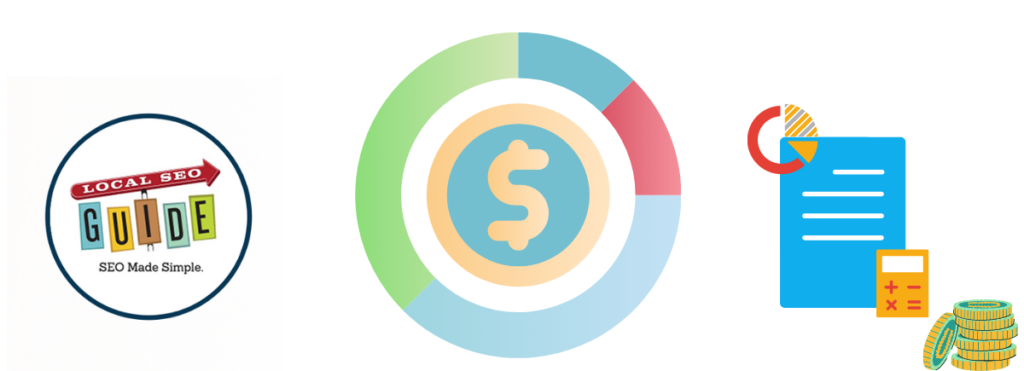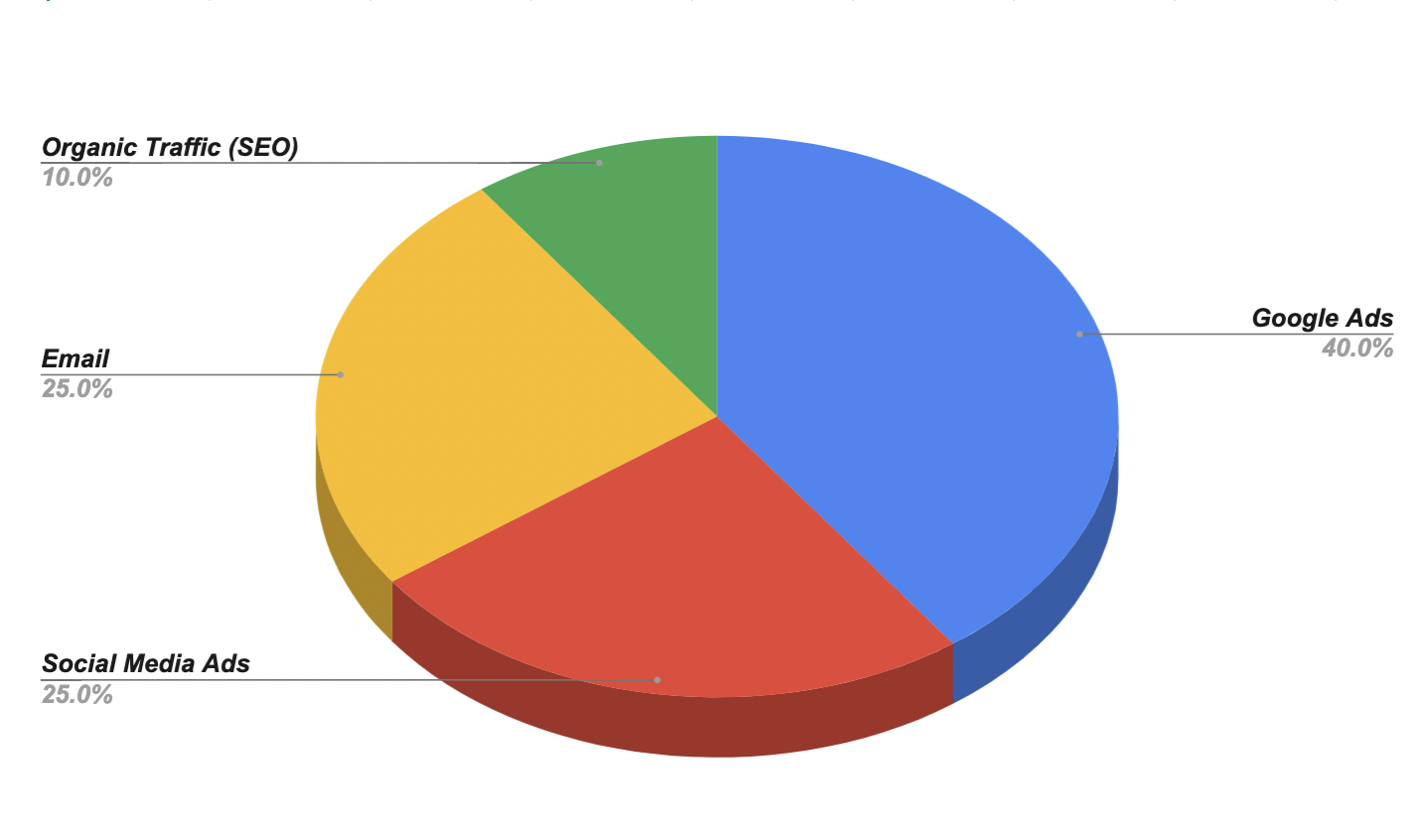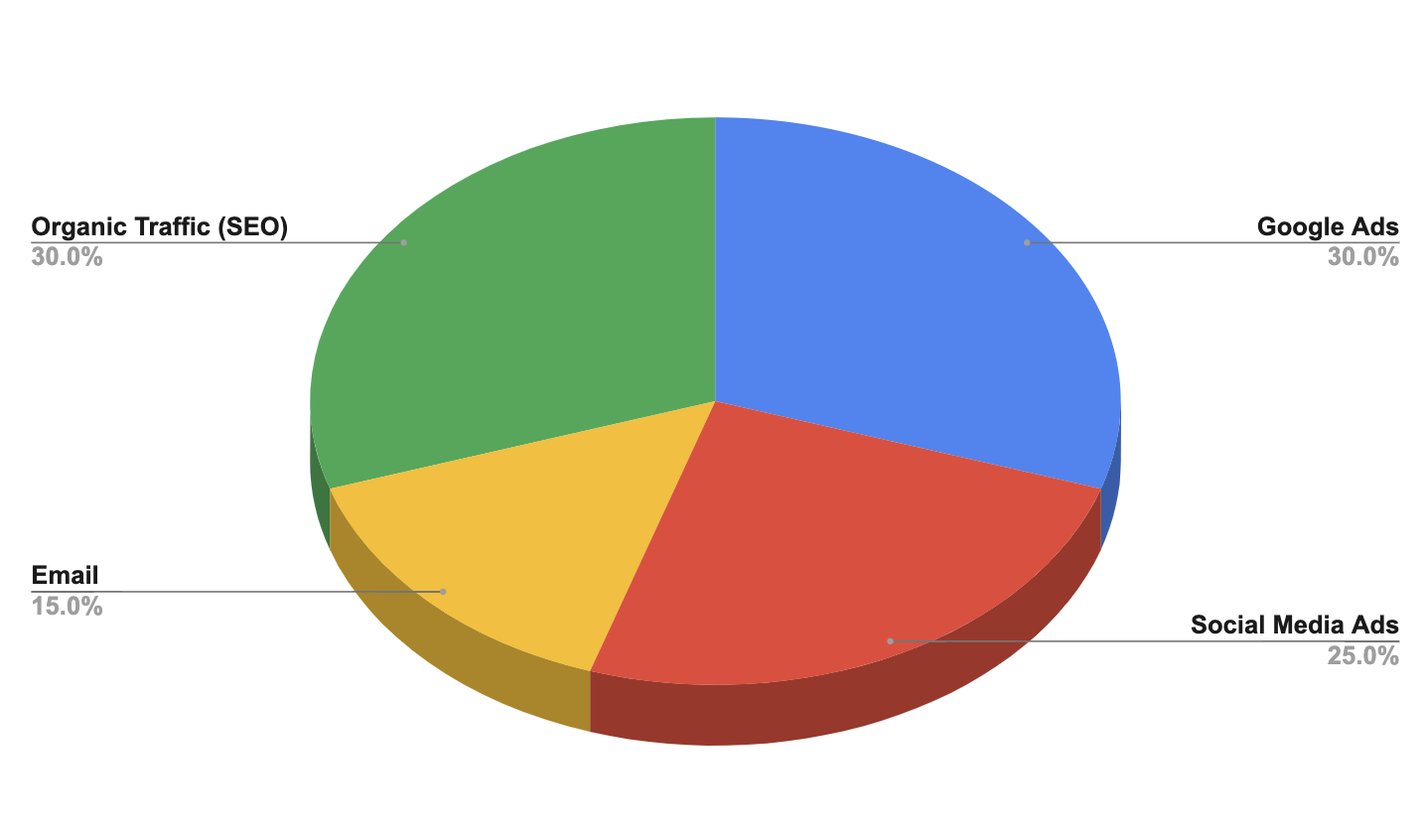If you are looking to know what amount of your digital marketing budget should be spent on SEO and how to spend your SEO investment, this is for you. We’ll cover the steps for building an SEO budget, the different SEO services you may need, and a range of how much SEO services can cost.

Table of Contents
- Why is SEO important?
- The Average Cost of SEO
- An SEO investment case study
- Steps for building an SEO budget
- What are the best tools for SEO on a budget?
What is SEO?
Search engine optimization (SEO) is the process of increasing the quality and/or quantity of user traffic to a website from search engines. SEO is considered to be an unpaid form of digital marketing due to its focus on organic traffic as opposed to paid marketing channels.
SEO strategies have to do with making sure that a website ranks well for key terms or keywords in search engine page results (SERPs). Generally, the higher a chosen term ranks in SERPs, the more likely it is that the website will see an increase in traffic with their intended target users.
Why is SEO important?
Search engine optimization is important for a number of key reasons including:
- Brand awareness
- User visibility
- Gaining a competitive advantage
- An SEO investment offers long-term benefits
- Maximizing your conversion rate
Brand Awareness & User Visibility
Whether you are an enterprise, multi-location retailer, or an e-commerce business you want your customers to be able to find you easily. The ability to appear in Google search results for branded, unbranded, and/or product keywords is directly related to the quantity of organic traffic you will receive.
Good SEO strategy and keyword research ensure that the right users have access to your website and products or services. These insights are equally true for local SEO and if you want to rank well on a larger geographic scale. All businesses should consider how easily they can be seen by their customers online via Google or other search engines.
Gaining a Competitive Advantage
The ability to rank above your competition, for similar terms, is a distinct advantage. You will receive more impressions and clicks the higher you rank, yes, but you also appear to be more authoritative than brands that rank below you. This is particularly the case for product or service searches. These tend to be users with informational or transactional intent (i.e they want to buy and perhaps don’t know your brand yet or didn’t think to come directly to you.) In this way, SEO investment helps you become discovered by new users without the use of a paid channel like Google Pay-per-click (PPC) or another form of paid search marketing.
SEO Investment Offers Long-term Benefits
SEO investment has lasting benefits beyond the initial costs. While paid channels can help deliver large amounts of traffic to your website they will dry up as soon as you stop dumping money into the channel. In this way, they are short-lived and transient. By contrast, SEO investments in quality content marketing can help increase your traffic in the short term and keep driving users to your site years down the road.
Maximizing Conversion Rate
A technical SEO inspection and strategy audit are not just useful for getting more users to your website. Once they are there, you will also want to optimize the amount that are converting. Several aspects of SEO can intertwine with additional reasons customers are not converting like user experience issues or poor site structure. A marketing strategy and budget that involves SEO will likely be able to curtail these issues before they are a problem and help triage ones that already exist like page loading speed or other core web vitals.
SEO is an Investment
A new SEO strategy may require an SEO audit, new content creation, link building, or increasing the amount of quality content that is already being produced each month. SEO agencies are no more able to predict instant growth or success than a social media guru but they do have data-backed methods for delivering real results and forecasting ROI for business owners and key stakeholders.
The Average Cost of SEO
So, how much of your marketing budget should be used to generate more organic search traffic? What’s the average cost of SEO services? This is going to depend a fair bit on the scope and scale of the business’ need and which SEO services it requires, of course, but we’ll run through some ranges for the average cost of different aspects of SEO work.
Technical SEO
Technical SEO is part of on-page SEO and has to do with optimizing elements on your site to make it increase in visibility as opposed to creating content to improve the authority of the domain via backlinks. Generally, on-page SEO concerns what terms you are ranking for while off-page deals with how high your site ranks. This means making sure page-specific elements like title tags, headings, content, and internal links match the keywords you want to target.
Broadly, the goal is often to make your site faster, easier to crawl, and more comprehensive for search engines. It’s often quite broad and can be (wrongly) detached from business objectives at some SEO agencies.
It’s common to request Technical SEO consulting when enterprise brands are beginning new SEO initiatives or doing Domain/site migrations and rebrands.
Cost of Technical SEO Audit: This can range from $2,500-$+15,000.
Your initial investment to diagnose any technical issues or current status might look something like this:
| Size | Approx. cost | Example |
| Small Technical Audit | $2,500 | B2B SaaS or other small-scale content sites |
| Medium Technical Audit | $7,500 | Mid-tier e-commerce site |
| Large Technical Audit | $15,000 | Any large-scale, multi-domain, and/or complicated site |
After the initial audit is completed, it may be recommended that you allocate some of your monthly SEO budget for technical consulting hours to ensure no issues arise on your site.
SEO Strategy & Keyword Research
An SEO strategy project, SEO Business Intelligence (BI), or SEO market research is much more intensive than a typical website audit. These include a web intelligence aspect and seek to address business opportunities and answer big questions often using big data.
This addresses unknown, unknowns in your market whereas Technical Audit addresses Known, unknowns. The boxes of potential problems in a technical audit can be broken down into areas of focus that are known. How well does your site render, crawl, index, and a host of standard issues? Technical audits generally don’t ask or answer new questions that are outside these boxes. BI and market research seeks to answer questions like:
- What is the best strategy to generate more organic traffic for a new product launch?
- How can I crush my competition in organic search traffic?
- What kind of website structure, landing pages, and features will draw in my target demographics?
- How can I generate more revenue and take advantage of new opportunities?
Market Research starts with understanding business objectives and fills in visibility gaps for business leaders using more business intelligence resources than a technical audit does. The reasons for a Business Intelligence project might include enterprise brands looking to gain a competitive advantage, startups looking to launch a new product/service, or companies trying to break into a new market.
Cost of SEO Strategy/Market & Keyword Research: This service has the most variation due to it being very tailored to business needs but this tends to be priced at or over $15,000. Not all projects take the same amount of time or computing costs, so the pricing tends to reflect that and is tiered depending on the scope of the project. BI/ Market Research might include:
- Business strategy and performance analysis
- Technical SEO audit
- Competitive Analysis
- Editorial Strategy
- Backlink Strategy
- Detailed Project Plan
Business intelligence projects can be a game-changer for businesses. We’ll discuss the case of Reciprocity’s SEO program yielding an ROI of 11:1, below.
Content Marketing
Content Marketing services can include a wide range of things such as content creation itself as well as content strategy, content refreshes, content briefs, or copywriting. The benefit of having an SEO agency develop your content and strategy is that it’s all turn-key. Nothing gets lost in translation and they can execute content that best aligns with the overall arching SEO strategy being pursued.
Even in a case where the content creation is outsourced to SEO writers they can ensure quality control. SEO strategies can fail if corners are cut in the content creation process or effective link-building strategies are not understood.
Cost of Content Marketing: Again, scope and scale matter here because the number of pieces of content, as well as their word count and the difficulty of the subject, will impact price. For content that requires little-to-no research and is around 500 words you may expect a price tag of around $250, but for a piece that requires a great deal of research or expertise, and is over 1500 words, might cost as much as $2,500. Additionally, product copy, location pages, and service pages normally range from $500-$750.
An SEO investment case study
Reciprocity is a great case study for understanding the value and potential impact of SEO investment. The company was founded in 2007 and was financially viable but failed to achieve online visibility outside its loyal client base.
LSG began working with Reciprocity in 2017 to help them address some of these key concerns. Namely, they wanted fresh ideas on how to drive more organic traffic as well as help in converting prospects to customers in the GRC software industry, where there’s just not a lot of search volume lower in the funnel.
Over the course of the engagement, LSG did a technical audit and provided SEO content strategy, link building, and editorial support for their content. These efforts allowed Reciprocity have serious gains in organic traffic. The site more than doubled organic traffic from November 2019 to June 2021 which led to several key business objectives being surpassed.
Key Metrics and Results:
- 11:1 ROI on the SEO program
- 900% increase in ARR, from $2M to $20M in 5 years
- More than 40% of all revenue is driven by SEO-related leads
You can read the full details of the Reciprocity case study if you want a deeper dive.
Steps for building an SEO budget
Before diving into the steps for building an SEO budget there are some key things to note. Remember that SEO is a long-term strategy. It can typically take four to six months to see small results and six to 12 months for satisfying results.
It’s unlikely that you’ll get a quick fix with a single SEO campaign. It’s also probable that you will need to spend money each month to maintain and implement SEO strategies. The budget can range heavily depending on what needs to be done such as:
- SEO strategy
- Ongoing SEO consulting
- Technical audit
- Content strategy & creation
- Link building
- Technical SEO
If you are a larger organization or you are if a more competitive market then chances are your costs will be higher. If you have SEO challenges it is likely you will see a few one-time initial costs on the higher end at the beginning. As these issues are resolved then your budget trend towards focusing more on SEO program maintenance that can include things like content creation and link building.
1. What does your Digital Marketing Budget currently look like?
The best place to start is by accessing your current spending on various marketing channels. This way you can see how much of a role SEO does and should play as a percentage of your budget.
Let’s pretend your current digital marketing spend is as follows:

Old SEO budget
You could begin by asking which channels are producing the least return on investment. For instance, if you find that email marketing is not doing so hot maybe we take a bit (10%) from that channel.
Then, we can see that a large portion of the budget is being spent on Google Ads (40%). Google Ads may offer a great amount of traffic now, but that traffic will dry up as soon as you stop pouring money into them. For this reason, we take a bit from this category (10%) too.
Now your budget looks like this:

New SEO budget
If you start by cutting away the fat on underperforming channels it should be easy to justify boosting investment in search engine optimization. Paid marketing is very attractive and can yield great results fast but SEO has the capability to generate more ROI over time.
When done correctly, it’s more sustainable and the organic growth can subsidize the cost of other marketing channels so you can expand the total marketing budget.
2. Make the Most of Your SEO Budget
Now that you’ve determined that SEO should account for 30% of your digital marketing budget, you can focus on the precise SEO areas to which you want to devote your resources.
Your SEO money should be used to improve the elements of your business that are now producing results.
You may want to focus on increasing your page speed or refreshing old blog posts with high-quality content, both of which would help your website rank higher.
It’s also a good idea to improve the user experience on both desktop and mobile, fix any technical issues, and add more connections to your content.
3. Contrast your SEO budget with your PPC budget.
The most salient benefit of Google Ads (PPC) is the speed it can give you results but you will pay for every click. It can be impactful for new businesses looking to gain targeted visitors quickly and (hopefully) get a positive return on investment. However, using Google Ads is similar to gambling – the system is simple to use, but if you don’t know how to manage well-executed Ad campaigns, you’ll continue to spend without realizing your full potential ROI.
Please don’t misunderstand us. Google Ads can still bring value to your digital marketing strategy. However, you should begin working on SEO as soon as possible because, in the long run, SEO will save you money and might bring better results.
4. Getting External Links
It’s difficult to get organic traffic to sales sites. Unless it’s a paid ad or product search results, product pages rarely appear on Google’s first search page. As a result, the most typical technique is to create content in order to drive visitors to your product pages.
There’s a variety of ways to improve your linking strategy such as:
Internal Linking
Internal linking can be a very useful way to funnel users into high-priority places. This is important also because it’s often hard to get product pages to rank well. Creating how-to articles or product evaluations can help drive traffic to product pages.
Guest Blogging
Guest blogging is one of the oldest and most effective techniques to obtain links from other websites. Bloggers adore having guest articles because it adds new information and opinions to their sites with little effort.
Look for sites that are reliable and related to your items, then pitch them on guest post ideas. If you’re on a tight budget, guest blogging is an excellent alternative because most blogs don’t charge for guest pieces.
Creating Unique & Citable Content
Another way to get backlinks is to think about what original content you can create that is citeable in your niche. This can mean infographics, research, tools, how-to & long-form articles, or anything that provides unique value or information that people would cite because you are an authority on the topic. If you need help figuring out how to prioritize and forecast SEO initiatives check out our RICE model and our forecasting tool.
What are the best tools for SEO on a budget?
-
- Ahrefs: Backlink Checker
- SEMRush: Search Competition & Keyword Research
- Screaming Frog: SEO website audit & website crawler
- SEO PowerSuite: Rank Tracker, Website Auditor, SEO SpyGlass & LinkAssistant.
- Google Search Console: Measure & track Search traffic and performance
- Google Keyword Planner: Use for new keyword ideas
- Google PageSpeed: Check your site speed & Core Web Vitals
- Google Analytics: identify trends & patterns in how users interact with your site. It also shows where user traffic is coming from and lets you track conversion goals.
These aren’t the only SEO tools out there but they are ones that perform critical functions and give you insights you should be aware of both for SEO strategy and fixing SEO issues.
The Bottom Line
Building a budget for SEO is likely less difficult than you might think. Investing in SEO can be easy to justify because it offers a number of benefits such as increasing your website traffic and the quality of your traffic as well as boosting your brand awareness. It also will help generate more revenue and increase your conversion rate. Beyond that, SEO investment has a very healthy ROI and offers long-term benefits in ways that other paid channels do not. If you are looking for SEO help or have questions feel free to reach out and contact us.
The post Building a Budget for SEO: How Much Does SEO Cost? appeared first on Local SEO Guide.




Recent Comments